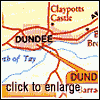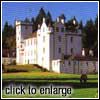|
Pitlochry
Returning to the notorious A9, a road that should
always be treated with care, you find the Victorian Spa town of Pitlochry, the touring
Mecca of Perthshire. There are plenty of hotels, restaurants, cafes, gift shops and
woollen mills to while away the day. Since the coming of the railway in 1863 it has
been a fashionable holiday or retirement spot and the town retains a Victorian air
of dignified repose. Queen Victoria favoured the spot with its longer-than-unusual
hours of sunshine and lack of rain.
One of the main attractions in the town is the Pitlochry
Dam which created Loch Faskally, an acceptable example of a man-made loch. There
are nine hydro stations in the Tummel Valley and the Exhibition and Visitor Centre
on the west side of the dam shows how hydro electricity works and how it benefits
the country and the environment.
 Next to the Visitor Centre is a fish ladder with an intriguing
observation chamber. Here it is possible to watch the migrating salmon take a rest
before tackling the next rung on the ladder. This helps the spawning fish to return
to their egg-laying grounds further up the river. Rowing boats are available on Loch
Faskally from a pier just beyond the Green Hotel. Next to the Visitor Centre is a fish ladder with an intriguing
observation chamber. Here it is possible to watch the migrating salmon take a rest
before tackling the next rung on the ladder. This helps the spawning fish to return
to their egg-laying grounds further up the river. Rowing boats are available on Loch
Faskally from a pier just beyond the Green Hotel.
Blair Atholl Distillery on the south side of the town
offers guided tours around one of the best known distilleries with a free dram available
at the end. There is an excellent whisky gift shop as well as a coffee shop.
Hidden away in woods 3 miles (5km) east of the town
is Edradour Distillery. Founded in 1825 by a group of farmers, this is one of the
most delightful little distilleries in Scotland.
Pitlochry is a good place for easy walks either north
towards Killiecrankie or south along the river and across the bridge to the Pitlochry
Festival Theatre. Its lively summer programme runs eight plays in 6 days. The tent-like
interior of the foyer reflects the old marquee from which the theatre started in
1951.
Just 1 mile (2km) or so south of Pitlochry is the
Dunfallandy Stone, and eighth-century Pictish Sculptured slab. Just outside Pitlochry
on the A924 going east is the interesting village of Moulin.
For exercise that will be rewarded, a path just behind
the Moulin Hotel will take you up an easy ascent to the top of Craigower Hill where
you can enjoy a magnificent view of Strath Tummel to the west. The church in the
village was rebuilt in 1874 on a site which was used for Christian worship for many
centuries.
The ruins of the thirteenth-century Castle Dubh are
also in the village. Legend has it that in 1500 the men of the castle contacted the
plague and, in an effort to contain the disease, cannon battered the stronghold down
with the soldiers inside. There now stands a mournful cairn for the men of the garrison.
A glimpse to your left as you travel north on the
A9 past Pitlochry reveals a deep wooded gorge, the scene of one of the most significant
battles in Scottish history. The Jacobite uprising in the late seventeenth and early
eighteenth centuries was an attempt by the supporters of the Stewart dynasty to prevent
the Hanoverian succession. In 1689, the first shots of this long and bloody struggle
were fired at the Pass of Killiecrankie.
Killiecrankie
The National Trust for Scotland centre at Killiecrankie
tells the story of the battle and the natural history of the area. It also provides
guides and ranger services. A much visited spot is the 'Soldier's leap' where a government
troop, Duncan MacBean, successfully leaped 18ft (5m) to escape the Highlanders. The
centre is open from March to October and there is a Trust shop and snack bar.
There is an excellent circular walk through varied
woodland from the Visitor's Centre to Pitlochry with options that take in the Pass
of Killiecrankie, River Garry, Loch Fascallay, Pitlochry Dam and Clunie Power Station.
Following the B8090 west out of Pitlochry turn left
at Garry Bridge. There is a car park at the far end of the bridge and it is worth
stopping to walk back and enjoy the views. Looking out from either side of the bridge
there are many fine vistas over the Pass of Killiecrankie with the rounded bulk of
Beinn a'Ghlo in the distance and the Rivers Garry and Tummel to the south. From here
the road twists and dips for a few miles but it makes for an interesting drive through
ever more beautiful countryside.
 The Queen's View, car park and Visitor Centre appear on the
left after a sharp bend. The spectacular vista that looks up the length of Loch Tummel
was brought to acclaim following Queen Victoria's visit in 1866 but it bore the same
title well before this. The loch has been enlarged with hydro electric schemes that
operate throughout these lochs and rivers. The new Visitor Centre illustrates the
activities taking place in Loch Tummel Forest including its wildlife and conservation
efforts. The Queen's View, car park and Visitor Centre appear on the
left after a sharp bend. The spectacular vista that looks up the length of Loch Tummel
was brought to acclaim following Queen Victoria's visit in 1866 but it bore the same
title well before this. The loch has been enlarged with hydro electric schemes that
operate throughout these lochs and rivers. The new Visitor Centre illustrates the
activities taking place in Loch Tummel Forest including its wildlife and conservation
efforts.
South of Loch Rannoch and visible from Queen's View
is the cone-shape of one of Perthshire's most distinctive mountains, the Schiehallion
at 3,547ft (1,082m), otherwise known as the Fairy Mountain of the Caledonians and
a place of worship for the Picts.
This is a popular hike for those that are suitably
equipped. A car park about 6 miles (10km) south of Tummel Bridge marks the beginning
of the walk which is quite steep at first but eases as you scale the magnificent
broad back of this mountain.
In 1774, the Schiehallion was used for early experiments
to judge the weight of the Earth, not very successfully, but in the process one of
the scientific members, Charles Hutton, invented Contour Lines as an aid in surveying
the mountain. It is possible to scale and descend Schiehallion in around 5 hours
but good hill walking boots are essential to cope with fields of shale near the top.
Following the B8090 from Queen's View brings you to
Tummel Bridge, Kinloch Rannoch and Rannoch Station. The road stays close to the loch
sides and offers the best views of Schiehallion's coned configuration. To the south
you can see the remains of a native pine forest, the Black Wood of Rannoch.
Blair Atholl
Returning to the A9, the village of Blair Atholl is
one of the last Perthshire outposts before going north through the Grampians at the
Drumochter Pass. It is popular for holidays, hill-walking, hunting and fishing.
Blair Atholl Mill in the village centre is a rebuilt
corn mill where you can follow the various stages of the process. The Atholl Country
Collection in the old school house gives a good insight into this area's past. The
museum exhibits tools and implements made by blacksmiths and wheelwrights from several
periods of the region's antiquity.
Blair Castle
 Blair Castle is one of the most popular visitor attractions
in Scotland. It began as a tower in 1269 then went on to become the centre of Atholl
Dukedom held successively by the Stewart and Murray families. It was occupied by
Cromwellian troops in 1652 and transformed into its present appearance in the nineteenth
century. Blair Castle is one of the most popular visitor attractions
in Scotland. It began as a tower in 1269 then went on to become the centre of Atholl
Dukedom held successively by the Stewart and Murray families. It was occupied by
Cromwellian troops in 1652 and transformed into its present appearance in the nineteenth
century.
The entrance to the castle is often graced by the
presence of the castle piper, welcoming visitors as they enter the halls. Inside
is a diverse collection of weapons, furniture and china from many different eras
in the castle's history. The Tapestry Room contains a noteworthy four-poster bed
topped with ostrich feathers. The Old Scots Room is a fascinating representation
of a typical Victorian estate worker's cottage, furnished with a box bed, a child's
cradle and spinning wheel. There are deer and Highland cattle in the surrounding
fields. Inside the castle, next to the gift shop, is a self-service licensed restaurant.
Amongst Blair Castle's most famous visitors are: Mary
Queen of Scots, Bonnie Prince Charlie, Robert Burns and Queen Victoria. Today, it
is the home of the present Duke of Atholl who is the only individual in Britain to
retain his own private army. The eighty strong Atholl Highlanders are the sole survivors
of the ancient clan system where the king relied on his chiefs to bring forth men
and build the king's forces.
About 4 miles (6km) north of Blair Atholl and positioned
just off the A9, is the House of Bruar, a new visitor centre which incorporates a
Clan Museum and Wild Flower Garden Centre. It also provides a Scottish retail outlet
par excellence.
Here you can purchase almost all your gifts and Highland
country wear at one stop. There is a magnificent Food Hall, Tartan and Tweed Hall,
Cashmere Room and Countrywear Shop as well as many assorted gifts of a uniquely Scottish
flavour. Some visitors must stop here for a cup of coffee and come out sporting a
full Highland shooting outfit. The quality, in all aspects of the House of Bruar,
is very high and it is worth saving your gift-buying time until you arrive here.
The restaurant is commendable also.
Nearby is the circular walk around the Falls of Bruar.
The route takes in several water-falls and deep pools which have cut through to expose
solid granite.
This point is the northern gate of Perthshire and
beyond is the Glen Garry and the Drumochter Pass into the Highland Region. Returning
south on the A9 towards Perth, the Hermitage, 2 miles (3km) west of Dunkeld, is an
agreeable nature trail through part of Craigvinian Forest to a waterfall and pool
on the River Braan. An ancient bridge leading to further forest walks crosses the
pool, called the Black Pool.
Above the falls is an eighteenth-century folly recently
refurbished which allows an impressive view of the cascading river and surrounding
woodland. Access to the falls and folly is available by car for the disabled.
|



